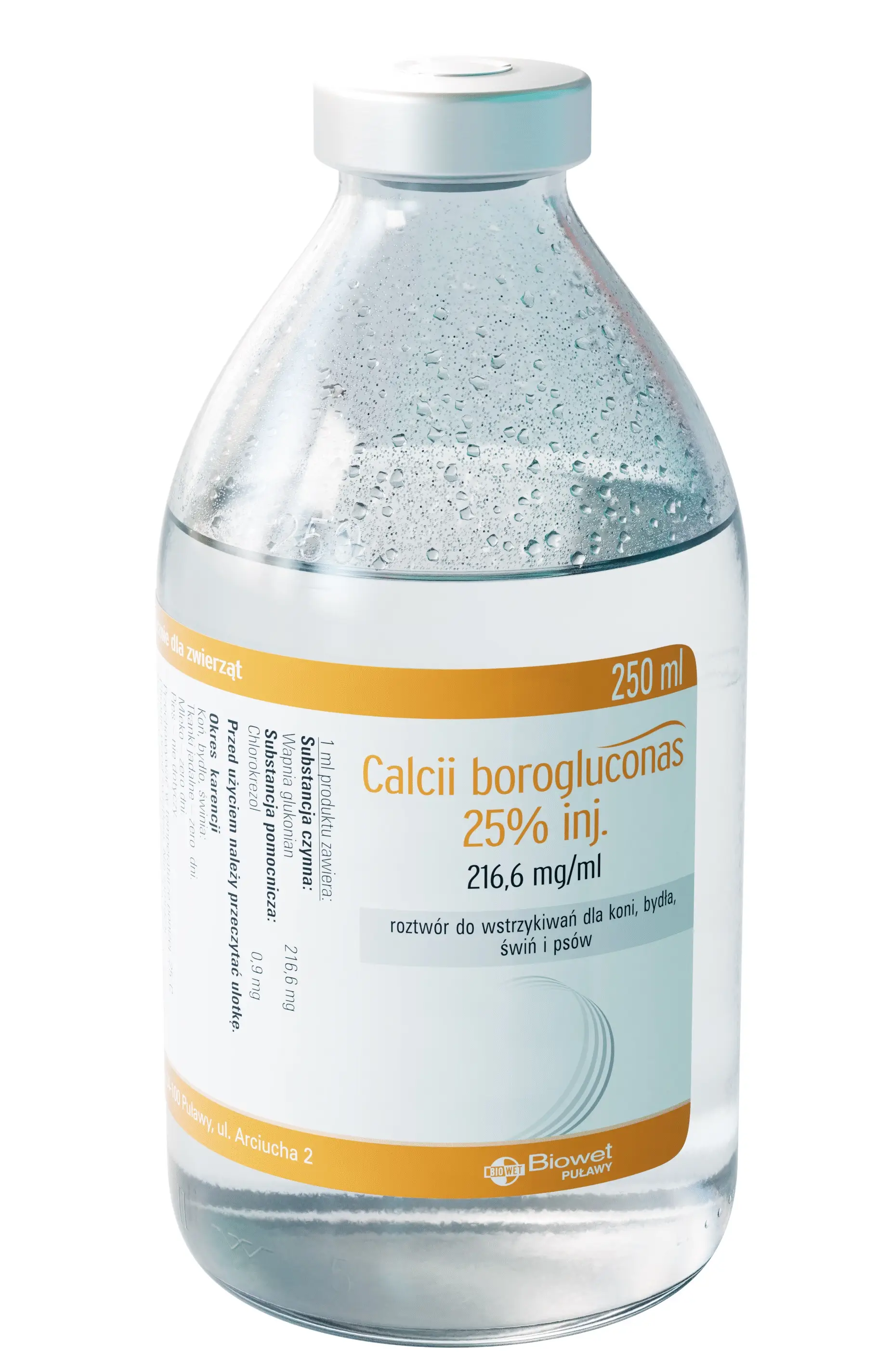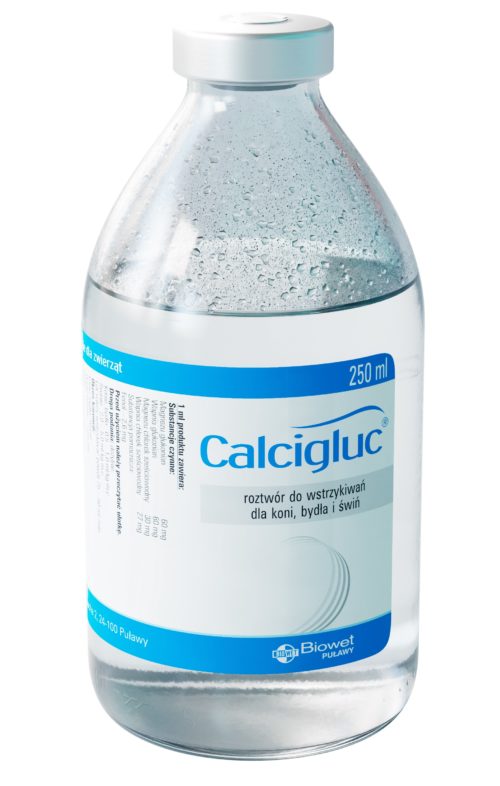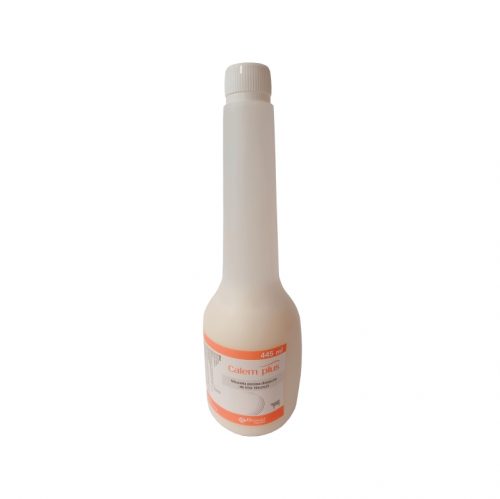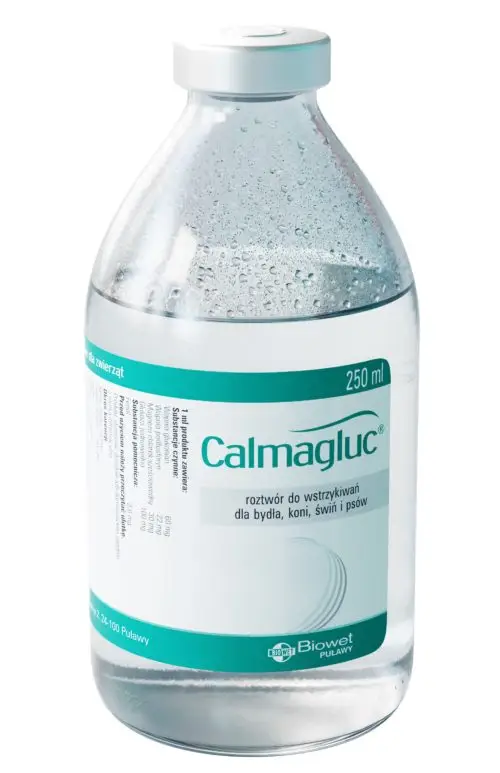Description
Solution for injections in calcium deficiencies
Active substance and excipient content
1 ml contains:
Active substance: Calcium gluconate 216.6 mg
Excipient: Chlorocresol 0.9 mg
Therapeutic indications
Treatment of calcium metabolism disorders resulting in hypocalcaemia (parturient paresis in cattle, pregnancy toxaemia in dogs, postpartum hypocalcaemia in swine) and conditions with increased neuromuscular excitability (transit tetany) or with paresis of the motor organs for various reasons (Downer cow syndrome).
As a supportive drug in the treatment of hypomagnesemic tetany, inflammatory and allergic conditions, particularly acute ones and with redness, as well as in cases of swelling and reduced blood oagulation.
Contraindications
Do not use in the case of kidney failure, liver failure, hyperparathyroidism and hypocalcaemia.
Adverse reactions
Intravenous administration of high doses of drugs particularly to animals in a general poor condition can result in hypercalcaemia. As a result bradycardia can occur, the strength of the cardiac contractions and frequency of contractions with AV nodal reentrant tachycardia and additional contractions increase. There is an acute myocardial hypoxia, and then muscle shaking, anxiety, sweating, decrease of blood pressure resulting in a collapse.
In order to identify the symptoms of over-dosage at a proper time, the heart beat should be monitored during the infusion.
In intramuscular and subcutaneous injections, and also in peri-intravenous administration some local reactions in a form of transient swelling can occur.
Any adverse reactions emerged after administration of the product or any observed symptoms not listed in the leaflet (including symptoms reported in humans following exposure to the product) should be reported to the competent veterinarian, Marketing Authorization Holder or the Office for Registration of Medicinal Products, Medical Devices and Biocidal Products. The report form should be downloaded from https://www.urpl.gov.pl (Department of Veterinary Medicinal Products).
Posology per each species, routes and methods of administration
The product should be administered intravenously or intramuscularly. In dogs it can also be administered subcutaneously.
The size of a dose calculated for 1 kg of the body weight should be varied depending on the nature of a disease and a general health condition of an animal:
- Acute hypocalcaemia – 0.8 ml / kg of body weight
- Acute inflammatory and allergic conditions – 0.4 ml / kg of body weight
- Poisoning, bleeding diathesis – 0.2 ml /kg of body weight
The above doses should be used once a day. In the case of acute hypocalcaemia a repeated dose can be applied after 6 hours. Subsequent administration of the drug can take place after 24 hours of the last application.
The product should be used for 1 – 3 days and if necessary the treatment should be extended with the preparation for oral application.
Recommendations for proper administration
In intravenous administration the preparation needs to be heated to the body temperature and injected slowly in the amount of 25-50 ml/min.
In intramuscular and subcutaneous administration the preparation should be applied in several places: 20-40 ml in one place in big animals and 2-3 ml in one place in small ones.
Withdrawal period
Horse, cattle, swine:
Edible tissues – zero days,
Milk – zero days,
Dog – not applicable.
Special precautions for storage
Keep out of the sight and reach of children.
Store at a temperature below 25°C. Protect from sunlight. Do not freeze
Do not use this veterinary medicinal product after the expiry date given on the label.
Durability after the first opening of the direct package – 28 days.
Special warnings
Special precautions for use in animals:
In order to avoid administration of too high a dose, the bodyweight of an animal has to be determined with the highest possible accuracy. Before intravenous administration the preparation needs to be heated to the body temperature. Do not exceed the recommended speed of infusion. During and directly after the end of administration the heart beat should be monitored. In the case of any cardiac disorders intravenous administration should be immediately stopped.
Special precautions for persons administering the medicinal veterinary product to animals:
Upon random self-injection seek medical help and provide a physician with the leaflet or the packaging.
Pregnancy:
No contraindications to apply during pregnancy.
Lactation:
No contraindications to apply during lactation.
Interactions with other medicinal products and other forms of interaction
Do not administer jointly with drugs from the group of cardiac glycosides with preparations including carbonate, phosphate, sulphate ions and with antibiotics from the group of tetracyclines. High doses of calcium are administered along with cardiac glycosides (derivatives of strophanthine and digoxin) strengthen their effect and can result in heart rhythm disorders. Thiazide diuretics increase reabsorption of calcium and increase a risk of hypercalcaemia. High doses of calcium administered along with Vitamin D can weaken the effect of drugs blocking the calcium channel.
Overdose (symptoms, procedures concerning immediate help and antidotes):
Overdose results in hypercalcaemia and hypercalcinuria. Symptoms of hypercalcaemia may include: nausea, vomiting, thirst, increased thirst, dehydration and constipation. Long-lasting overdose resulting in hypercalcaemia can cause vascular and organ calcification. Calcium supplementation in excess of 2000 mg/day , taken for several months, constitutes a threshold and may be a cause of poisonings.
In the case of over-dosage one must immediately stop the treatment and supplement the fluid deficiency. In the case of long-term over-dosage oral and intravenous rehydration with NaCl solutions should be applied. At the same time (or also after rehydration) loop diuretics (e.g. furosemide) are applied in order to increase calcium excretion and prevent the increase in the fluid volume.
Thiazide diuretics should not be administered.
Pharmaceutical incompatibilities:
Since no studies of the conformity of this veterinary medicinal product have been conducted, this product must not be combined with other medicinal veterinary products.
Special precautions for the disposal of unused veterinary medicinal product or waste materials derived from the use of such products
Medicines should not be disposed of via wastewater or household waste.
Ask your veterinary surgeon how to dispose of medicines no longer required. These measures should help to protect the environment.
Shelf life 2 years
Available containers 250 ml.
Subject to medical prescription – prescription drug.
Tobe administered under veterinary supervision.
For animal treatment only.
Marketing autorisation 1170/01
2015-11-17 SPC
31.08.2017 r.






